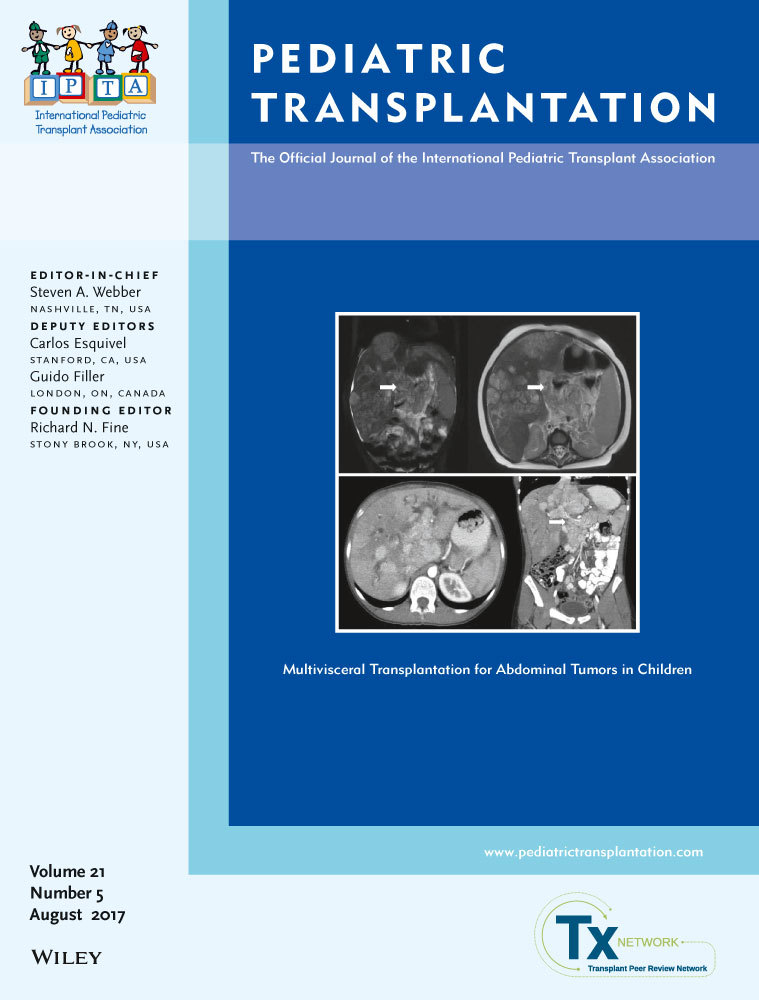EDITORIAL
Two sides of the Epstein-Barr virus (EBV) coin: Long-term control of EBV after liver transplantation?
Masaki Yamada,
Andrew J. Nowalk,
Masaki Yamada
Children's Hospital of Pittsburgh of UPMC, Pittsburgh, PA, USA
Search for more papers by this authorCorresponding Author
Andrew J. Nowalk
University of Pittsburgh School of Medicine, Pittsburgh, PA, USA
Correspondence
Andrew J. Nowalk, University of Pittsburgh School of Medicine, Pittsburgh, PA, USA.
Email: [email protected]
Search for more papers by this authorMasaki Yamada,
Andrew J. Nowalk,
Masaki Yamada
Children's Hospital of Pittsburgh of UPMC, Pittsburgh, PA, USA
Search for more papers by this authorCorresponding Author
Andrew J. Nowalk
University of Pittsburgh School of Medicine, Pittsburgh, PA, USA
Correspondence
Andrew J. Nowalk, University of Pittsburgh School of Medicine, Pittsburgh, PA, USA.
Email: [email protected]
Search for more papers by this authorNo abstract is available for this article.
REFERENCES
- 1Rowe DT, Qu L, Reyes J, et al. Use of quantitative competitive PCR to measure Epstein-Barr virus genome load in the peripheral blood of pediatric transplant patients with lymphoproliferative disorders. J Clin Microbiol. 1997; 35: 1612-1615.
- 2Narkewicz MR, Green M, Dunn S, et al. Decreasing incidence of symptomatic Epstein-Barr virus disease and posttransplant lymphoproliferative disorder in pediatric liver transplant recipients: report of the studies of pediatric liver transplantation experience. Liver Transpl. 2013; 19: 730-740.
- 3Bingler MA, Feingold B, Miller SA, et al. Chronic high Epstein-Barr viral load state and risk for late-onset posttransplant lymphoproliferative disease/lymphoma in children. Am J Transplant. 2008; 8: 442-445.
- 4Green M, Soltys K, Rowe DT, Webber SA, Mazareigos G. Chronic high Epstein-Barr viral load carriage in pediatric liver transplant recipients. Pediatr Transplant. 2009; 13: 319-323.
- 5Lau AH, Soltys K, Sindhi RK, Bond G, Mazariegos GV, Green M. Chronic high Epstein-Barr viral load carriage in pediatric small bowel transplant recipients. Pediatr Transplant. 2010; 14: 549-553.
- 6Kullberg-Lindh C, Saalman R, Olausson M, Herlenius G, Lindh M. Epstein-barr virus DNA monitoring in serum and whole blood in pediatric liver transplant recipients who do or do not discontinue immunosuppressive therapy. Pediatr Transplant. 2017; 21: e12875 https://doi.org/10.1111/petr.12875
- 7Macedo C, Webber SA, Donnenberg AD, et al. EBV-specific CD8+ T cells from asymptomatic pediatric thoracic transplant patients carrying chronic high EBV loads display contrasting features: activated phenotype and exhausted function. J Immunol. 2011; 186: 5854-5862.
- 8Dharnidharka VR, Webster AC, Martinez OM, Preiksaitis JK, Leblond V, Choquet S. Post-transplant lymphoproliferative disorders. Nat Rev Dis Primers. 2016; 2: 15088.
- 9Ahn E, Youngblood B, Lee J, Lee J, Sarkar S, Ahmed R. Demethylation of the PD-1 promoter is imprinted during the effector phase of CD8 T cell exhaustion. J Virol. 2016; 90: 8934-8946.
- 10Macedo C, Donnenberg A, Popescu I, et al. EBV-specific memory CD8+ T cell phenotype and function in stable solid organ transplant patients. Transpl Immunol. 2005; 14: 109-116.
- 11Smets F, Sokal EM. Epstein-Barr virus-related lymphoproliferation in children after liver transplant: role of immunity, diagnosis, and management. Pediatr Transplant. 2002; 6: 280-287.
- 12Preiksaitis JK, Pang XL, Fox JD, et al. Interlaboratory comparison of Epstein-Barr virus viral load assays. Am J Transplant. 2009; 9: 269-279.




